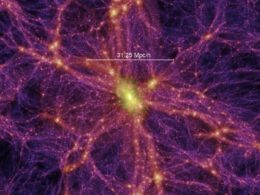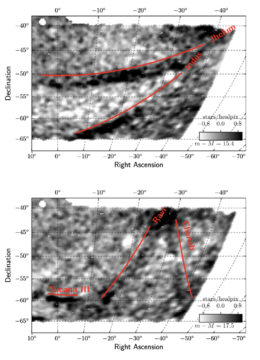Over billions of years, globular clusters and dwarf galaxies orbiting the Milky Way have been torn apart and stretched out by tidal forces. The disruption of these ancient stellar populations results in narrow trails of stars called stellar streams. These stellar streams can help us understand how the Milky Way halo was constructed and what our galaxy’s dark matter distribution is like — but how do we find them?

Along with cosmological simulations, like the Millennium Simulation pictured here, stellar streams can help us understand how dark matter is distributed in galaxies like the Milky Way. [Max Planck Institute for Astrophysics]
On the Trail of Tidal Streams
Understanding how our galaxy came to look the way it does is no easy task. Trying to discern the structure and formation history of the outer reaches of the Milky Way from our vantage point on Earth is a bit like trying to see the forest for the trees — while also trying to learn how old the forest is and where the trees came from!
One way to do so is to search for the stellar streams that form when globular clusters and dwarf galaxies are disrupted and torn apart by our galaxy. Stellar streams tend to be faint, diffuse, and obscured by foreground stars, which makes them tricky to observe. Luckily, recent data releases from the Dark Energy Survey are perfectly suited to the task.

Top: Density map of stars with a distance modulus of 16.7 for a given matched-filter isochrone. Bottom: Stellar streams identified in this work, including those previously known. Click to enlarge. [Shipp et al. 2018]
Dark Energy Survey Brings Faint Stars to Light
Nora Shipp (University of Chicago) and collaborators analyzed three years of data from the Dark Energy Survey in search of these stellar streams. The Dark Energy Survey is well-suited for stellar-stream hunts since it covers a wide area (5,000 square degrees of the southern sky) and can observe objects as faint as 26th magnitude.
Shipp and collaborators use a matched-filter technique to pinpoint the old, low-metallicity stars that belong to stellar streams. This method uses the modeled properties of stars of a certain age — synthetic isochrones — to identify stars within a background stellar stream with minimal contamination from foreground stars.
Using their matched filters, the authors found 15 stellar streams, 11 of which had never been seen before. They then estimated the age, metallicity, and distance modulus for each stream — all critical to understanding how the individual streams fit into the larger picture of galactic structure.

A closer look at the stellar streams in the first quadrant of the surveyed area. Top: Density map of stars with a distance modulus of 15.4. Bottom: Stars with a distance modulus of 17.5. [Adapted from Shipp et al. 2018]
Reconstructing the Galactic Halo
These 11 newly discovered stellar streams will greatly enhance our understanding of the history of the galactic halo. Spectroscopy can help clarify the ages of these structures, while kinematic studies can help us understand if and how these structures are associated.
Future work may also help us discern the origin of the streams; the stark dichotomy in the mass-to-light ratios of the stellar streams discovered in this work hints that it may be possible to link some streams to globular clusters and others to dwarf galaxies. Look for this and more exciting results from galactic archaeologists in the future!
Citation
N. Shipp et al 2018 ApJ 862 114. doi:10.3847/1538-4357/aacdab


1 Comment
Pingback: The Milky Way has been shot with an invisible gun — and the criminal has gotten away - Firstpost - Trending News Blog